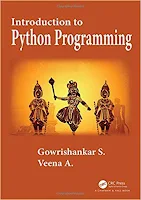Introduction to Python Programming
Gowrishankar S., Veena A. ... 464 pages - Publisher: Chapman and Hall/CRC; (November, 2018) ... Language: English - ISBN-10: 0815394373 - ISBN-13: 978-0815394372
Introduction to Python Programming is written for students who are beginners in the field of computer programming. This book presents an intuitive approach to the concepts of Python Programming for students. This book differs from traditional texts not only in its philosophy but also in its overall focus, level of activities, development of topics, and attention to programming details. The contents of the book are chosen with utmost care after analyzing the syllabus for Python course prescribed by various top universities in USA, Europe, and Asia. Since the prerequisite know-how varies significantly from student to student, the book’s overall overture addresses the challenges of teaching and learning of students which is fine-tuned by the authors’ experience with large sections of students. This book uses natural language expressions instead of the traditional shortened words of the programming world. This book has been written with the goal to provide students with a textbook that can be easily understood and to make a connection between what students are learning and how they may apply that knowledge.
Introduction to Python Programming is written for students who are beginners in the field of computer programming. This book presents an intuitive approach to the concepts of Python Programming for students. This book differs from traditional texts not only in its philosophy but also in its overall focus, level of activities, development of topics, and attention to programming details. The contents of the book are chosen with utmost care after analyzing the syllabus for Python course prescribed by various top universities in USA, Europe, and Asia. Since the prerequisite know-how varies significantly from student to student, the book’s overall overture addresses the challenges of teaching and learning of students which is fine-tuned by the authors’ experience with large sections of students. This book uses natural language expressions instead of the traditional shortened words of the programming world. This book has been written with the goal to provide students with a textbook that can be easily understood and to make a connection between what students are learning and how they may apply that knowledge.





